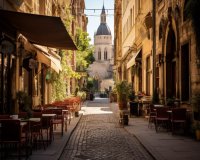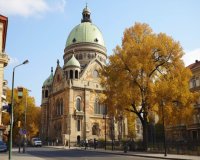Walking Tour of Budapest’s City Center

Exploring Budapest's City Center: A Walking Tour
Budapest, the capital of Hungary, is a city steeped in history, culture, and stunning architecture. One of the best ways to immerse yourself in the heart of this beautiful city is by taking a walking tour of its city center. In this article, we'll guide you through a delightful walking tour of Budapest's city center, highlighting the must-visit landmarks and sharing interesting insights along the way.
Starting Point: St. Stephen's Basilica
Your journey begins at St. Stephen's Basilica, a magnificent neo-classical cathedral dedicated to Hungary's first king. As you approach, you'll be awed by its grandeur and the panoramic views from the dome. Don't forget to explore the interior, especially the stunning cupola and the hand of St. Stephen himself.
Andrássy Avenue
From St. Stephen's Basilica, head towards Andrássy Avenue, one of Budapest's most prestigious boulevards. Lined with beautiful villas and townhouses, this avenue is a UNESCO World Heritage Site. As you stroll down the tree-lined avenue, you'll pass iconic landmarks like the Hungarian State Opera House and the House of Terror Museum.
Heroes' Square and City Park
Continuing along Andrássy Avenue, you'll arrive at Heroes' Square, a vast square adorned with statues of Hungarian national heroes. Adjacent to the square is City Park, a sprawling green oasis. Here, you can visit Vajdahunyad Castle, an architectural marvel, and soak in the serene atmosphere of the park.
The Széchenyi Thermal Bath
If you're feeling weary from your explorations, take a break at the Széchenyi Thermal Bath, one of Budapest's most famous thermal spas. The soothing thermal waters and the stunning architecture of the bathhouse will rejuvenate your spirits.
Andrássy Avenue, Continued
As you make your way back along Andrássy Avenue, you'll encounter high-end boutiques, cafes, and embassies. It's an excellent place for some leisurely window shopping and people-watching. The street itself is a work of art, so be sure to look up and admire the exquisite facades.
The Hungarian Parliament Building
Heading towards the Danube River, you'll soon spot the iconic Hungarian Parliament Building. This imposing neo-Gothic structure is one of the most recognized symbols of Budapest. You can also enjoy a scenic cruise along the Danube to get a different perspective of this architectural masterpiece.
Shoes on the Danube Bank
Not far from the Parliament Building, you'll find the poignant "Shoes on the Danube Bank" memorial. These iron shoes along the riverbank serve as a somber reminder of the victims of World War II. It's a powerful and moving tribute to history.
The Buda Castle District
For the final leg of your walking tour, cross the Chain Bridge to the Buda side of the city. Here, you'll find the Buda Castle District, a historical gem with its medieval streets and the grand Buda Castle overlooking the city. Don't miss the Fisherman's Bastion for stunning views of Budapest.
Conclusion
Your walking tour of Budapest's city center is a journey through time and culture, offering a glimpse of the city's rich history and vibrant present. Each step you take reveals new stories, architectural wonders, and cultural treasures. Whether you're a history enthusiast, an architecture lover, or simply a curious traveler, Budapest's city center has something to offer everyone.
So, put on your most comfortable walking shoes, grab a map, and embark on this unforgettable adventure through the heart of Budapest.
Enjoy your exploration of Budapest's city center!
Budapest: The Great Synagogue Skip the Line Ticket
Explore Budapest's iconic Great Synagogue, the largest in Europe and second-largest globally, with this skip-the-line ticket. Delve into the rich history of Hungarian Jews before and after WWII on a guided tour. Visit the Heroes’ Temple, the graveyard, and the Jewish Museum. Pay respects at the Emmanuel Memorial Tree in the Raoul Wallenberg Memorial Park.
Highlights:
- Enjoy skip-the-line entry to the Great Synagogue, the largest in Europe and second-largest globally.
- Explore the synagogue grounds, including the Heroes’ Temple, the graveyard, and the Jewish Museum.
- Learn about Hungarian Jewish history, especially during WWII, through informative guided tours.
- Visit the Emmanuel Memorial Tree, a poignant tribute to Holocaust victims, in the Raoul Wallenberg Memorial Park.
Begin your tour by skipping the lines and heading straight to the security check at Dohány Street Synagogue. Marvel at the stunning architecture of the synagogue, learn about the fate of Hungarian Jews before and after WWII, and gain insights into the daily life of the Jewish community in Hungary.
Explore the synagogue's premises, including the Heroes’ Temple and the graveyard, gaining a deep understanding of the historical significance of these sites. Then, proceed to the Jewish Museum to witness a vast collection of everyday objects, shedding light on the life of Jewish people in Hungary.
Pay your respects at the Emmanuel Memorial Tree in the Raoul Wallenberg Memorial Park, a powerful symbol honoring Holocaust victims. The tree's metal leaves are engraved with the names of victims and plaques dedicated to non-Jewish rescuers.
Please note the synagogue's rules: visitors are expected to dress modestly, and men must cover their heads. A kippah is provided at the entrance. Also, be aware of the security check upon entry and the prohibition of eating, drinking, or smoking in the area.
Don't miss this opportunity to gain a profound understanding of Hungarian Jewish heritage and history by visiting the Great Synagogue and its surrounding sites.
Meeting Point: Present your voucher directly at the security check at Dohány Street Synagogue.
Important Information:
- The Synagogue is closed on Saturdays and Jewish holidays.
- Appropriate attire is required, including no sleeveless tops, short skirts, or shorts.
- Face masks are recommended, although not mandatory.
- Backpacks larger than hand luggage are not allowed inside.
Price: From $24.98 per person.
Book your skip-the-line ticket now to embark on a journey through Hungarian Jewish history at the Great Synagogue.
History and Landmarks of Budapest
Budapest, the capital city of Hungary, is a city steeped in history and adorned with stunning landmarks that tell the tale of its rich past. From its ancient roots to its modern-day splendor, Budapest has a story that captivates all who visit.
Ancient Origins
The history of Budapest can be traced back to the Roman Empire when it was known as "Aquincum." This ancient settlement was a bustling hub for trade and commerce, and remnants of Roman baths and amphitheaters can still be seen today.
However, it was during the Middle Ages that Budapest began to take shape as a significant European city. Buda and Pest, the two halves of the city separated by the Danube River, were inhabited by various tribes and peoples, including the Huns, Magyars, and Ottomans. The city's diverse cultural influences are reflected in its architecture and traditions.
The Habsburg Era
In the 18th century, Budapest came under Habsburg rule, and this period saw the construction of some of the city's most iconic landmarks. One such landmark is Buda Castle, a magnificent palace perched atop Castle Hill, offering breathtaking views of the Danube and the Pest side of the city.
The Chain Bridge, another marvel of engineering and design, was built in the mid-19th century and connected Buda and Pest, uniting the two sides of the city. This bridge remains a symbol of Budapest's unity and strength.
20th Century Challenges
The 20th century brought both triumph and turmoil to Budapest. World War I and the Treaty of Trianon reshaped Hungary's borders, and the city lost significant territory. However, Budapest rebounded, embracing a vibrant cultural scene and becoming known as the "Paris of the East."
Tragically, Budapest suffered greatly during World War II, with many historic buildings damaged or destroyed. The city's Jewish Quarter, home to the famous Great Synagogue, bore witness to the horrors of the Holocaust. Today, this area stands as a solemn reminder of the past.
Modern Budapest
After World War II, Budapest entered the Soviet sphere of influence and became the capital of communist Hungary. The city underwent significant changes during this period, with new socialist architecture and monuments erected.
However, in 1989, the winds of change swept through Budapest as Hungary embraced democracy. The fall of the Iron Curtain opened the city to the world, and Budapest quickly regained its status as a vibrant European capital.
Landmarks of Budapest
Budapest boasts a wealth of landmarks that showcase its history and culture:
| Landmark |
Description |
| Parliament Building |
The iconic Neo-Gothic parliament building along the Danube is a symbol of Hungarian democracy. |
| St. Stephen's Basilica |
This stunning cathedral is dedicated to Hungary's first king and offers panoramic views from its dome. |
| Fisherman's Bastion |
A fairy-tale-like structure on Castle Hill with turrets and panoramic terraces. |
| Gellért Hill |
This hill offers fantastic views of the city and is home to the Liberty Statue. |
| Széchenyi Thermal Bath |
One of Budapest's famous thermal baths, where visitors can relax in mineral-rich waters. |
Conclusion
Budapest's history is a tapestry of triumph and adversity, and its landmarks are the threads that weave this story together. Whether you're exploring the grandeur of Buda Castle or taking in the panoramic views from Fisherman's Bastion, Budapest's past and present converge in a city that never fails to captivate.
So, when you visit Budapest, remember that you're not just exploring a city; you're stepping into the pages of a remarkable history filled with resilience, culture, and beauty.
Budapest Grand Jewish Heritage Tour
Explore the vibrant tapestry of Budapest's Jewish heritage on this enlightening half-day tour. Uncover the deep-rooted cultural, historical, and religious connections between Hungarian and Jewish traditions, woven together over centuries.
Embark on a journey through significant landmarks, including the iconic Dohány Street Synagogue, the largest synagogue in Europe. Delve into the rich exhibits of the Jewish Museum, paying homage to the Martyrs’ Cemetery and the poignant Raoul Wallenberg Memorial Park.
Immerse yourself in the heart of the Jewish Quarter, once the Ghetto, adorned with synagogues, monuments, and authentic kosher establishments. Wander through streets with tales narrated by your knowledgeable guide, offering insights into Budapest's history.
Discover the Memorial Park dedicated to Carl Lutz, known as "Hungary’s Schindler," and traverse the famous Gozsdu Passage. Visit the Kazinczy Street Synagogue, a masterpiece of art-nouveau architecture and one of Europe's largest operating orthodox synagogues.
Conclude your tour with a choice—indulge in a delightful treat at the glatt kosher Fröhlich confectionery or enjoy a 10% discount at the glatt kosher Carmel Restaurant.
Highlights
- Visit the Dohány Synagogue, the largest in Europe
- Explore the Jewish Museum and Martyrs’ Cemetery
- Experience the solemnity of Raoul Wallenberg Memorial Park
- Wander through the historic Jewish Quarter
- Discover the Kazinczy Street Synagogue, a masterpiece of art-nouveau
Includes
- Professional guide throughout the tour
- Entrance fees to key sites
- Option for cake at the glatt kosher Fröhlich confectionery or 10% off at Carmel Restaurant
Book now and delve into the captivating Jewish heritage of Budapest, where history and culture intertwine.
Hidden Gems of Hungary's Capital: Budapest
Budapest, the enchanting capital of Hungary, is renowned for its stunning architecture, thermal baths, and vibrant culture. While iconic landmarks like the Buda Castle and Chain Bridge are well-known, there are hidden gems in this city waiting to be discovered by intrepid travelers. Let's embark on a journey to uncover the lesser-known treasures of Budapest.
1. Vajdahunyad Castle
Hidden in plain sight, Vajdahunyad Castle is a fairytale-like structure located in City Park. This architectural gem was built to celebrate the millennium of Hungary and boasts a blend of various architectural styles. Wander through its enchanting courtyards and discover the mysterious beauty within.
2. Hospital in the Rock
Beneath the Castle Hill lies a secret world, the Hospital in the Rock. Originally a natural cave system, it was transformed into a hospital during World War II and the Cold War. Explore this subterranean labyrinth, complete with wax figures and medical equipment, to gain insights into Budapest's wartime history.
3. Memento Park
For a taste of Hungary's communist past, visit Memento Park. This open-air museum is home to a fascinating collection of statues and monuments from the country's socialist era. It's a thought-provoking experience that sheds light on Hungary's history and transformation.
4. Szimpla Kert Ruin Bar
Enter the quirky world of Budapest's ruin bars, with Szimpla Kert being one of the pioneers. Housed in an abandoned building, this ruin bar is a vibrant hub of creativity and culture. Explore its eclectic decor, enjoy live music, and savor unique cocktails in an atmosphere like no other.
5. Fisherman's Bastion at Sunrise
While Fisherman's Bastion is not entirely hidden, the magic lies in visiting at sunrise. The soft morning light paints the city in a warm glow, and you can often have this breathtaking viewpoint all to yourself. It's a serene and unforgettable experience.
6. Gellért Hill Cave Church
Tucked away in the Gellért Hill, the Cave Church is a serene sanctuary carved into the rock. It offers a tranquil escape from the bustling city and provides a glimpse into Budapest's spiritual side. The atmosphere inside is both peaceful and awe-inspiring.
7. Kerepesi Cemetery
Explore Budapest's history through its famous cemetery, Kerepesi Cemetery. Here, you'll find the final resting places of many prominent Hungarians, including artists, politicians, and scientists. It's a place of reflection and a unique way to learn about the country's influential figures.
8. Margaret Island
Margaret Island, nestled in the Danube River, is an oasis of tranquility in the heart of Budapest. It's a green paradise with gardens, musical fountains, and even a small zoo. Rent a bike or take a leisurely stroll to enjoy the island's natural beauty.
9. The Great Market Hall
While not exactly hidden, the Great Market Hall is often overshadowed by Budapest's more famous attractions. This bustling market is a sensory delight, offering a vast array of Hungarian delicacies, crafts, and souvenirs. It's the perfect place to savor local flavors and pick up unique gifts.
10. The Budapest Pinball Museum
For a dose of nostalgia and a break from traditional sightseeing, head to the Budapest Pinball Museum. It houses a remarkable collection of vintage pinball machines and arcade games. Spend hours reliving the past and challenging your friends to retro gaming fun.
In conclusion, Budapest is a city that never ceases to amaze, with hidden gems waiting to be discovered at every turn. Beyond its well-known attractions, these lesser-known treasures add depth and intrigue to your Budapest experience. So, take the road less traveled and uncover the secrets of Hungary's captivating capital.






